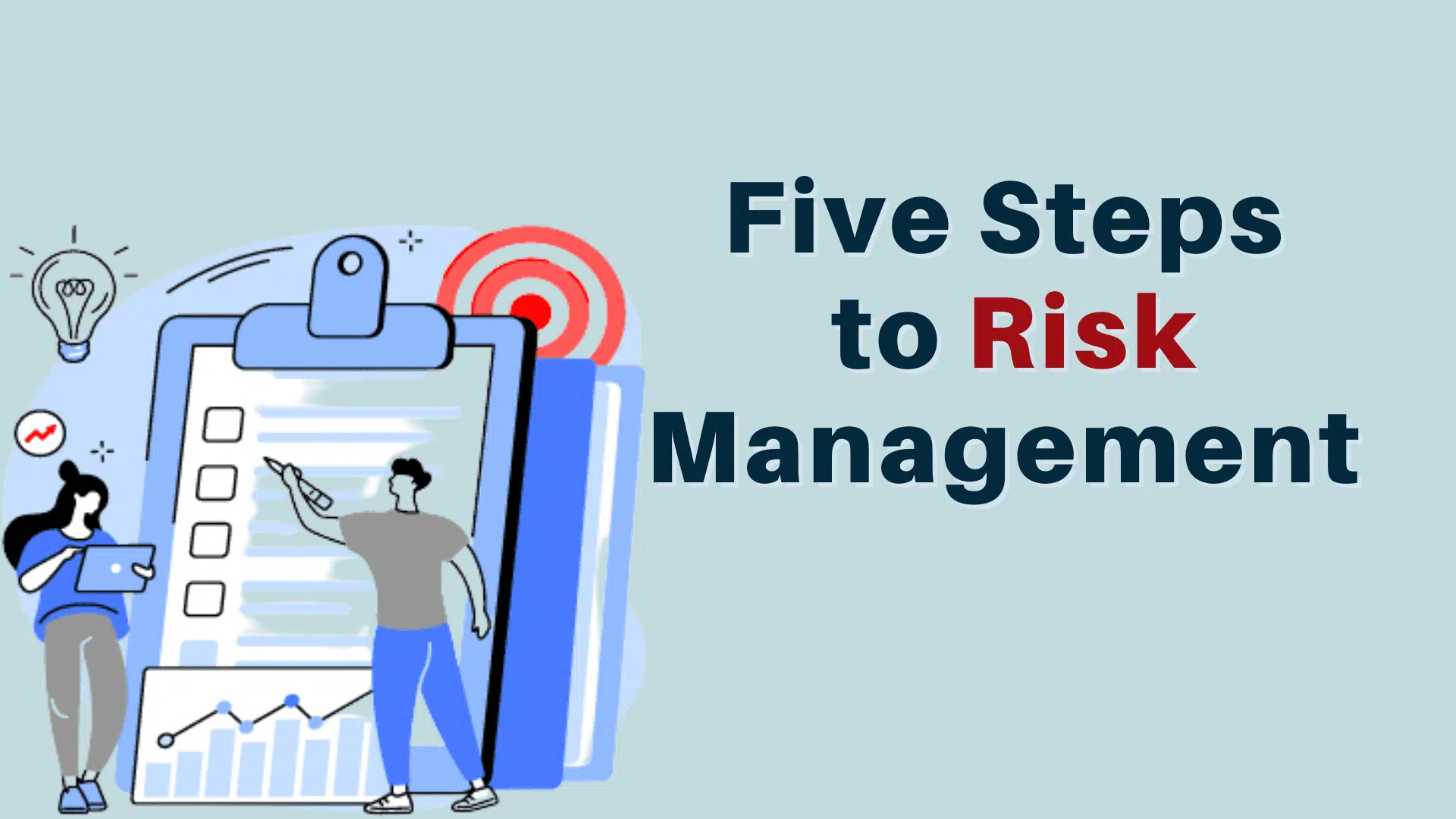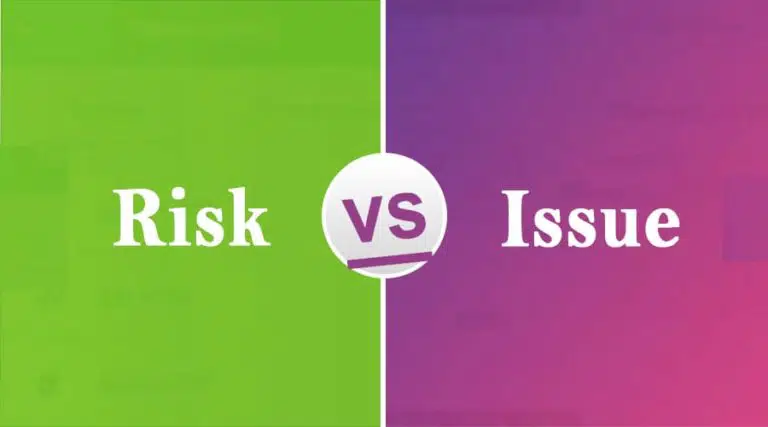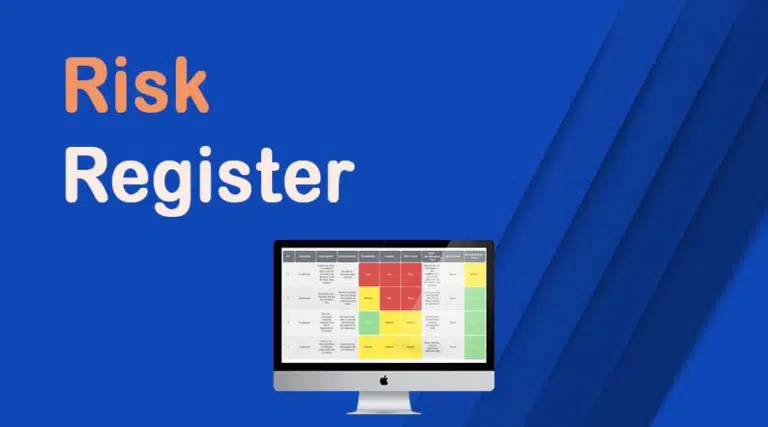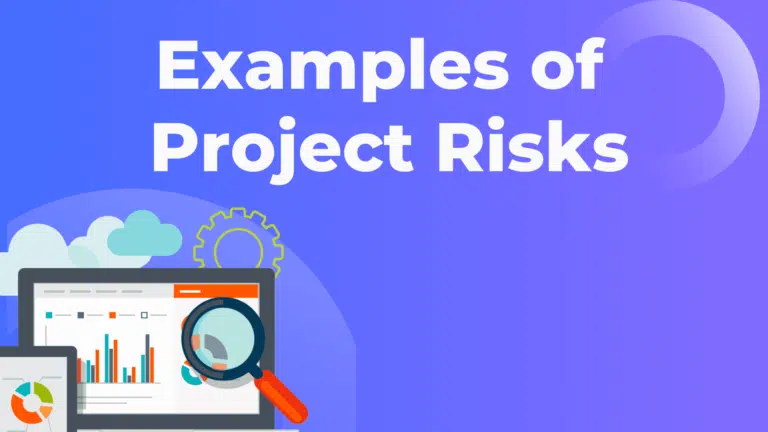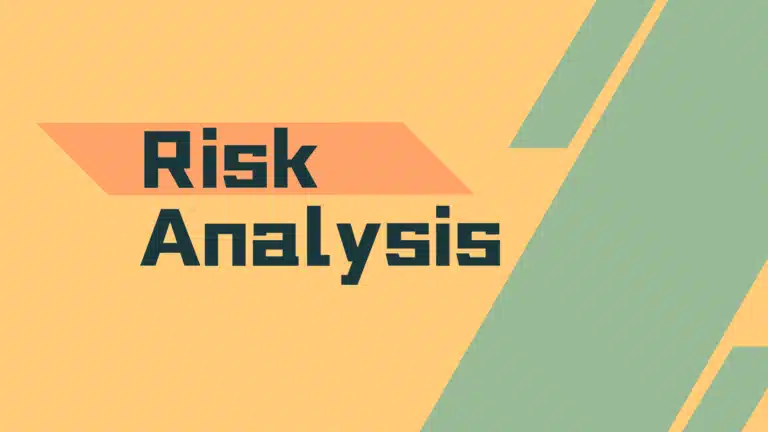Risk management or enterprise risk management (ERM) is crucial in today’s dynamic and unpredictable business environment. Organizations face many risks that can threaten their projects, operations, reputation, and bottom line. Businesses are left vulnerable to potential crises and financial losses without a structured approach to identify, assess, and manage these risks.
Organizations must adopt a risk management framework to manage these uncertainties successfully.
This article outlines five steps to risk management to help businesses develop an effective risk management strategy. Following these steps, you can identify risks, evaluate their impact and likelihood of occurrence, develop risk responses, implement measures, and control them.
Each step plays a vital role in risk management. By taking a systematic approach, you can minimize disruptions, enhance resilience, and seize opportunities.
This article will explore all five steps to risk management in detail and provide practical insights and recommendations. By implementing these steps, you can foster a risk-aware culture, enable better decision-making and safeguard your project’s success or business operations.
Five Steps to Risk Management
The five steps to risk management are as follows:
- Risk Identification
- Risk Analysis
- Developing Response Strategies
- Implement Risk Responses
- Risk Monitoring and Control
Step#1. Risk Identification
You can have different types of risks in your project or business, and you must identify them before you start your work.
Risk identification involves identifying all possible risks, including threats and opportunities from internal or external sources.
Define the Objectives and Scope of Risk Management
Before starting risk identification, creating a risk management plan, establishing clear objectives, and defining the organization’s risk management scope are important. This involves understanding the organization’s goals, values, and risk appetite.
Organizations can prioritize efforts and allocate resources efficiently by aligning risk management objectives with the overall business objectives.
Establish a Risk Identification Process
Risk identification requires a systematic approach. Brainstorming sessions, checklists, interviews, surveys, and data analysis can be useful techniques for collecting risks.
It is crucial to consider internal factors, such as operational processes, technology, and personnel, and external factors, like market conditions, regulatory changes, and geopolitical events.
Involve Key Stakeholders and Subject Matter Experts
Risk identification and assessment should not be limited to a single department or individual. Involving your team members, key stakeholders from different departments, and subject matter experts is essential.
These individuals bring diverse perspectives, knowledge, and experience, enhancing risk identification accuracy and comprehensiveness. Involving stakeholders also promotes ownership and buy-in for risk management efforts.
Review OPA
OPA stands for Organizational Process Assets, including a database of past projects, lessons learned, project documents, risk logs, templates, etc. You can review these files and get risks for your current project.
Reviewing past files can provide valuable information on your current risks.
Create and Maintain a Risk Register
Documenting and maintaining a risk register ensures a systematic approach. The risk register is a repository of identified project risks, their assessment details, and corresponding response strategies.
This project document helps track risk management activities, monitor profile changes, and support decision-making. Regular risk register updates and reviews are essential to keep it relevant.
The risk identification process lets you prioritize risks based on their significance and likelihood, providing a solid foundation for the subsequent risk management steps.
Step#2. Risk Analysis
After identifying the risks, the next step in risk management is analyzing those risks.
Risk analysis involves assessing the potential consequences of identified risks and determining their likelihood of occurrence. This step in risk management provides insights into the significance of risks, rank the risks, and helps prioritize responses. You can then separate the risks into different categories.
You can group risks into four major categories: hazard risks like fires or natural disasters; strategic risks like the entry of new competitors; financial risks like economic recession; and operational risks like the poor performance of a key supplier.
You can also create a risk breakdown structure to categorize the identified risks.
You can have the highest priority risk, medium priority risk, or low priority risk. Low-priority risks you can place on a watchlist for future monitoring.
Assessing Consequences
In risk analysis, you evaluate the impact of each identified risk on your project objectives, operations, finances, reputation, etc. This assessment involves considering both direct and indirect consequences that may arise from the occurrence of a risk event.
Consequences can range from financial losses, operational disruptions, legal and regulatory penalties, reputational damage, and harm to human health and safety. Understanding the potential repercussions helps quantify the potential impact of risks on the organization.
Determining Likelihood
In addition to assessing consequences, you must evaluate the chances of occurrence of each identified risk. Likelihood assessment involves analyzing historical data, industry trends, expert opinions, and other relevant information to estimate the chances of a risk event.
Categorize and Prioritize Risks
Once you have identified the risks, categorize them based on their impact and chance of occurrence. This categorization helps in prioritizing risks and allocating appropriate resources for mitigation efforts.
For example, you can categorize risks as strategic, financial, operational, compliance, reputational, and emerging. In addition, you should assess each risk based on its potential impact and likelihood of occurrence.
Qualitative and Quantitative Risk Analysis Techniques
Risk analysis can be performed using qualitative and quantitative techniques or both, depending on the nature of the risk and available data. Quantitative analysis involves using numerical data and statistical methods to quantify the impact and likelihood of risks.
Qualitative analysis, on the other hand, relies on expert judgment, subjective assessments, and risk matrices to evaluate risks qualitatively based on predefined criteria or scales.
Techniques such as scenario analysis, sensitivity analysis, and probabilistic modeling (e.g., Monte Carlo simulations) can provide more accurate estimations of risk exposure and potential outcomes.
For simple projects, qualitative risk analysis is enough. However, for large and complex projects, quantitative risk analysis is required.
Risk Assessment Tools
Risk assessment tools help systematically organize and prioritize risks based on their significance and likelihood. Common tools include risk matrices, expected monetary value, decision trees, fault trees, and bowtie diagrams.
These tools visually represent risks, their causes, consequences, and possible control measures. These tools enhance the accuracy and efficiency of the analysis process.
Considering Inherent and Residual Risk Levels
Inherent risk represents the level of risk before implementing any control measures, while residual risk reflects the level of risk that remains after implementing risk response strategies.
Assessing both inherent and residual risk levels helps you understand the effectiveness of your risk management efforts and identify gaps or areas that require further attention.
Step#3. Developing Risk Response Strategies
Once risks have been identified and analyzed, the next crucial step in risk management is developing response strategies for treating risks. Risk responses involve taking proactive measures to reduce the likelihood or impact of negative risks and increase the likely hood or impact of positive risks.
By developing appropriate strategies, you can minimize the negative consequences and realize the available opportunities.
You can use the following strategies to manage risks:
Risk Avoidance
Risk avoidance involves eliminating or discontinuing activities or processes that pose significant dangers to the organization. For example, this could include avoiding entering high-risk markets, discontinuing using hazardous materials, or refraining from engaging in risky business ventures.
While risk avoidance may not always be feasible or desirable, it is an effective strategy for eliminating certain risks.
Risk Mitigation
A risk mitigation plan focuses on implementing measures to reduce the likelihood or impact of risks. This can involve improving processes, implementing safety measures, enhancing security protocols, or conducting regular maintenance and inspections.
Organizations can significantly reduce risk events’ potential occurrence or severity by identifying specific control measures and implementing best practices. Risk reduction strategies aim to create a safer and more secure environment.
Risk Sharing
Risk sharing involves sharing the risk consequences with external parties. You can achieve this through contracts, partnerships, or other risk-sharing mechanisms. This is a positive risk response strategy.
For example, you can tie up with other organizations to buy some consumables in bulk to get a better discount.
Risk Acceptance
Organizations may accept certain risks by carefully evaluating their potential impact and likelihood. This strategy is often for risks that are relatively low in severity or where the cost of mitigation outweighs the potential benefits.
Risk acceptance does not mean ignoring or neglecting risks but rather consciously deciding not to pursue further mitigation measures. Therefore, it is important to document the rationale behind risk acceptance decisions and regularly review them to ensure they remain valid.
Contingency Planning and Business Continuity
Contingency planning and business continuity strategies are essential components of risk planning. These strategies involve developing robust plans and procedures to respond effectively to risk events and ensure the continuity of critical business operations.
Contingency plans outline specific actions to take in the event of a risk occurrence. In contrast, business continuity plans ensure that the organization can continue operating during and after a disruptive event. As a result, organizations can minimize downtime, mitigate losses, and recover swiftly from risk events by having contingency and business continuity plans.
You should tailor risk mitigation strategies to the risks and the organization’s risk attitude.
#4. Implement Risk Responses
Implementing risk responses involves responding to risk events. This step enables organizations to navigate uncertainties effectively, minimize the impact of risk events, and enhance overall resilience.
Incident Response and Recovery
Organizations must have a well-defined incident response plan when a risk event occurs. This plan outlines immediate actions to mitigate the event’s impact, minimize further damage, and initiate recovery.
The incident response may involve activating emergency protocols, notifying stakeholders, allocating resources, and implementing contingency measures. Timely and effective response helps mitigate the consequences of events and facilitates a quicker return to normal operations.
Learning from Risk Events
Risk events provide valuable lessons for organizations to learn from and improve their management practices. Following a risk event, conduct a thorough analysis to understand its causes, the effectiveness of existing mitigation measures, and any gaps or shortcomings in the management process.
By identifying the root causes and lessons learned, organizations can implement corrective actions and enhance their risk management strategies to prevent similar events from occurring in the future.
Continuous Monitoring and Adaptation
Risk management is an ongoing process. Therefore, you need to continually monitor the effectiveness of your risk management strategies, assess emerging risks, and adapt approaches accordingly.
This involves staying abreast of industry trends, regulatory changes, technological advancements, and other factors that may impact the organization’s risk landscape.
You can proactively adopt risk management strategies to address new or evolving risks and maintain your competitive edge.
Stakeholder Engagement and Communication
Effective communication with stakeholders is critical during the risk response and implementation phase. Organizations should engage with key stakeholders, including employees, customers, suppliers, regulators, and shareholders, to keep them informed about risk events, mitigation efforts, and changes in management strategies.
Transparent and open communication helps build trust, manage expectations, and foster a risk-aware culture across the organization.
Integration into Decision-Making Processes
You should integrate risk management into the organization’s decision-making processes. Organizations can assess risks and opportunities more effectively by considering risk implications when making strategic, operational, and financial decisions.
This integration ensures that risk management becomes integral to the organization’s culture, guiding decision-making and enabling informed choices that balance risk and reward.
Organizations can effectively manage risk events, learn from them, and continually improve their management strategies by adopting a proactive and adaptive approach to risk response and adaptation.
This ongoing process helps organizations stay resilient, agile, and well-prepared to navigate uncertainties in an ever-changing business environment.
Let’s now move to the last and fifth steps to risk management.
#5. Monitor and Control Risks
Risk management is an ongoing and dynamic process requiring continuous monitoring and control to ensure effectiveness. Risk monitoring and control involve actively tracking identified risks, evaluating the performance of risk mitigation measures, and making necessary adjustments to address emerging threats or changing circumstances.
This step is crucial for maintaining a proactive approach to management and minimizing disruptions.
Establish Key Performance Indicators (KPIs)
Organizations should establish key performance indicators (KPIs) that align with their risk management objectives to monitor risks effectively. KPIs provide measurable targets and benchmark where you can assess the performance of risk mitigation efforts.
These indicators may include metrics related to risk exposure, incident frequency, financial impact, or compliance with risk management policies. Clear and well-defined KPIs enable organizations to track progress and identify areas that require attention or improvement.
Risk Monitoring Tools and Techniques
Various tools and techniques can facilitate the monitoring and control of risks. For example, risk dashboards, automated alerts, and data analytics can provide real-time or periodic insights into the status of identified risks and the effectiveness of mitigation strategies.
Regular internal and external audits, inspections, or assessments can also help identify gaps or deficiencies in risk controls. By leveraging these tools and techniques, organizations can enhance their ability to detect and respond to risk events promptly.
Communication and Reporting Mechanisms
Effective risk monitoring and control depend on open communication and robust reporting mechanisms. Therefore, you should establish regular communication channels to facilitate the flow of risk-related information across different levels and departments within the organization.
This includes reporting risk incidents, near misses, or potential emerging threats. Timely and accurate reporting enables swift decision-making and prompt action to address risks.
Risk Committees and Ownership
Organizations may consider establishing dedicated committees or assigning risk owners to oversee monitoring and control efforts. Risk committees can provide a centralized forum for discussing risk-related matters, reviewing risk performance, and making informed decisions regarding management strategies.
On the other hand, risk owners are responsible for monitoring specific risks, implementing mitigation measures, and reporting on their status. These structures help ensure accountability and effective coordination of management activities.
Review and Continuous Improvement
Regular reviews of risk management processes and outcomes are essential for continuous improvement. Therefore, organizations should conduct periodic evaluations to assess the effectiveness of risk monitoring and control efforts.
This includes reviewing incident reports, analyzing trends, and seeking stakeholder feedback. In addition, you should document lessons learned from risk events and near misses to refine management strategies and enhance future decision-making.
By establishing robust monitoring and control mechanisms, organizations can proactively identify risk profile changes, assess mitigation measures’ effectiveness, and take prompt action to address emerging dangers. This step ensures that risk management remains integral to the organization’s operations and supports maintaining a resilient and sustainable business.
Conclusion
Risk management is vital to organizational success, enabling businesses to proactively identify, assess, mitigate, and adapt to potential threats. Organizations can establish a robust and comprehensive risk management framework by following the five steps to risk management outlined in this article. This framework helps protect the organization from potential threats, enhances decision-making, and promotes a risk awareness and resilience culture.
Effective risk management requires commitment, collaboration, and ongoing effort from all levels of the organization. By integrating risk management into everyday practices and continuously improving risk management strategies, organizations can confidently navigate uncertainties, seize opportunities, and safeguard their long-term success.

I am Mohammad Fahad Usmani, B.E. PMP, PMI-RMP. I have been blogging on project management topics since 2011. To date, thousands of professionals have passed the PMP exam using my resources.

